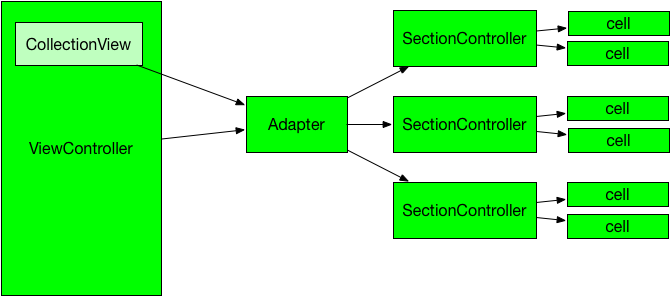IGListKit是一个数据驱动的UICollectionView框架,用于构建快速和灵活的列表。这个框架设计的非常好,完美符合高内聚、低耦合,这个解耦思路可以借鉴。它是一个很典型的使用 Objective-C 开发的,但却是个偏向使用 Swift 语言开发者的一个 UI 组件库。这里尽可能用通俗易懂的方式来描述。
master
可以通过cocoaPods安装这个组件,在podfile中添加:
target 'yourProjectName' do
use_frameworks!
pod 'IGListKit'
end
原来的做法:在原来的UICollectionViewController里的写法,我们一定都会实现UICollectionDataSource和UICollectionViewDelegate来细化数据源和用户交互响应等,详细的可以参考相关文档这里就不赘述。
IGListKit的做法:
-
创建section controller,继承IGListSectionController,遵循IGListSectionType协议
一个 section controller 是一个抽象的对象,指定一个数据对象,它负责配置和管理 CollectionView 中的一个 section 中的 cell。这个概念类似于一个用于配置一个 view 的 view-model:数据对象就是 view-model,而 cell 则是 view,section controller 则是二者之间的粘合剂。在 IGListKit 中,根据不同类型的数据的类型和特性创建不同的 section controller
class LabelSectionController: IGListSectionController, IGListSectionType {
// ...
}
-
创建UI
使用 UICollectionView,你需要某个数据源实现 UICollectionViewDataSource 协议。它的作用是返回 section 和 row 的数目以及每个 cell。 在 IGListKit 中,你使用一个 GListAdapter 来控制 collection view。你仍然需要一个数据源来实现 IGListAdapterDataSource 协议,但不是返回数字或 cell,你需要提供数组和 controllers
let layout = UICollectionViewFlowLayout()
let collectionView = IGListCollectionView(frame: CGRect.zero, collectionViewLayout: layout)
let updater = IGListAdapterUpdater()
let adapter = IGListAdapter(updater: updater, viewController: self, workingRangeSize: 0)
adapter.collectionView = collectionView
adapter.dataSource=self
- 连接数据源(实现objects、listAdapter和emptyView方法)
func objects(for listAdapter: IGListAdapter) -> [IGListDiffable] {
//数据源
var items:[IGListDiffable] = [wxScanner.currentWeather]
items+=loader.entries as [IGListDiffable]
items+=pathfinder.messages as [IGListDiffable]
return items.sorted(by: { (left: Any, right: Any) ->Bool in
if let left = left as? DateSortable,let right = right as? DateSortable{
return left.date > right.date
}
return false
})
}
func listAdapter(_ listAdapter: IGListAdapter, sectionControllerFor object: Any) -> IGListSectionController {
//根据不同数据源来返回对应的section controller
if object is Message{
return MessageSectionController()
}else if object is Weather{
return WeatherSectionController()
}else{
return JournalSectionController()
}
}
func emptyView(for listAdapter: IGListAdapter)->UIView?{
//当list是空的时候显示的视图
return nil
}
- 在section Controller中实现IGListSectionType协议要求必须实现的方法,实际上UICollectionDataSource和UICollectionViewDelegate的方法通过adapter在section controller中用下列方法实现
func numberOfItems() -> Int {
return 1
}
func sizeForItem(at index: Int) -> CGSize {
guard let context = collectionContext else{
return .zero
}
return MessageCell.cellSize(width: context.containerSize.width, text: message.text)
}
func cellForItem(at index: Int) -> UICollectionViewCell {
let cell = collectionContext?.dequeueReusableCell(of: MessageCell.self, for: self, at: index) as! MessageCell
cell.messageLabel.text = message.text
cell.titleLabel.text = message.user.name.uppercased()
return cell
}
func didUpdate(to object: Any) {
message = object as? Message
}
func didSelectItem(at index: Int) {
}
-
section controller 布局方式
这个方法在每个 JournalSectionController 对象的下方增加 15 个像素的间距,根据具体情况可以自己设置。保证上下cell之间有15个像素的空间
override init(){
super.init()
inset = UIEdgeInsets(top: 0, left: 0,bottom: 15, right: 0)
}
3、高级特性
-
Diffing算法
相比于前端各种各样 Virtual DOM diff 实现,移动端在这方面较为欠缺。在 UITableView 和 UICollectionView 的使用上,一旦同时发生数据删除,更新,添加时,我们的做法往往是手动计算出变化 NSIndexPaths并调用批量刷新,甚至简单粗暴地调用 reloadData 做一次全刷新。而IGListKit 的 IGListDiff正是为这种场景而生:当数据变化产生后,通过调用 IGListDiff 自动计算前后两次的差值,为后续批量刷新提供数据。整个算法的复杂度为 O(n),相当高效。
算法介绍:
IGListDiff 使用一个额外的哈希表和两个新旧哈希列表 hash entry list使得比较的算法复杂度从 O(n^2) 变成 O(n),一个hash entry定义如下:
/// Used to track data stats while diffing. struct IGListEntry { /// The number of times the data occurs in the old array NSInteger oldCounter = 0; /// The number of times the data occurs in the new array NSInteger newCounter = 0; /// The indexes of the data in the old array stack<NSInteger> oldIndexes; /// Flag marking if the data has been updated between arrays by checking the isEqual: method BOOL updated = NO; };然后进行比较操作,主要是四步:
- 遍历新队列,计算对象
hash值并找到对应entry,使得newCount++,同时计入new entry list - 遍历旧队列,计算对象
hash值并找到对应entry,使得oldCount++,同时将当前序号入栈oldIndexes.push(i),并记录old entry list - 遍历
new entry list,检查entry对应的oldIndexes信息,如果堆栈中有旧队列序号值,则表示当前entry至少对应新旧队列中的两个对象,即发生所谓的entry match,进行记录,方便后续反向查询。再通过检查新队列当前对象和entry 对应旧对象是否相同确认update状态。 - 再次遍历新旧
entry list,检查每个entry的entry match状态- 没有
entry match的对象,在新队列中的被标记为insert,而在旧队列中的则被标示为delete - 有
entry match的对象通过比较新旧队列序号和update状态分表表示为update,move和not modified
- 没有
举个栗子:
以旧数组
[1,2,3]和新数组[1,3,5]为例 (数字比较直接忽略update状态)- 遍历新数组,得到
[entry1,entry3,entry5]列表,记为nl - 遍历旧数组,得到
[entry1,entry2,entry3]列表,记为ol - 遍历
nl,由于entry1 oldIndexs = [0],entry3 oldIndexes = [2]所以他们是entry match,做记录 (reverse lookup) - 遍历
olentry1有entry match,跳过entry2没有entry match,记为deleteentry3有entry match,跳过
- 遍历
nlentry1有entry match,同时相对位置不变,记为not modified(其实就是跳过)entry3有entry match,但是相对位置变化,记为moveentry5没有entry match,记为insert
- 输出一个包含
insert,move,delete和update列表信息的最终结果
- 遍历新队列,计算对象
-
working range
working range是一个离可视区域之外的前后距离,这可以让section controllers在进入屏幕之前准备显示的内容,如预下载和预渲染等操作。
let adapter = IGListAdapter(updater: IGListAdapterUpdater(),
viewController: self,
workingRangeSize: 0.5) // 0.5 the workingRange size
同时有IGListWorkingRangeDelegate协议,提供sectionControllerWillEnterWorkingRange和sectionControllerDidExitWorkingRange方法分别是进入working range和离开working range区域执行的方法
3、栗子
本文的demo来自于网上的一个教程,依照教程的方法把UICollectionView迁移到IGListKit。同时库自身带有很多栗子可以参考学习。
